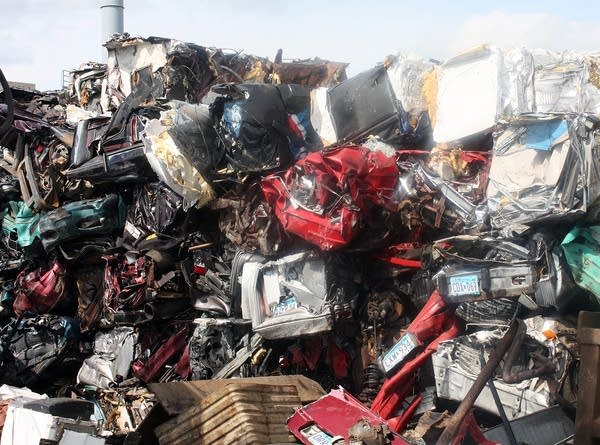Some question the environmental impact of clunkers program
Go Deeper.
Create an account or log in to save stories.
Like this?
Thanks for liking this story! We have added it to a list of your favorite stories.

The "cash for clunkers" program was touted as a way to stimulate the economy while helping the environment by getting gas guzzlers off the road. But some experts say the legislation doesn't go far enough to help the environment.
Many environmentalists are complaining that Cash for Clunkers isn't as green as they hoped it would be.
"It doesn't have particularly stringent fuel economy requirements and it has some flaws," said Derek Larson, an environmental studies professor at the College of Saint Benedict and Saint John's University.
Under the program, people who trade in old cars that get 18 miles per gallon or less get cash toward a more fuel-efficient one. If the new vehicle gets between 4 and 10 mpg more than the old vehicle, people get a $3,500 credit. If the new vehicle gets at least 10 mpg more than the traded-in vehicle, the credit is $4,500.
Turn Up Your Support
MPR News helps you turn down the noise and build shared understanding. Turn up your support for this public resource and keep trusted journalism accessible to all.
There is an exception. People who drive large vans, pickup trucks, and sport utility vehicles -- the biggest gas guzzlers -- can purchase a new vehicle that gets just 2 more miles to the gallon to qualify for the lower amount. Larson notes the new vehicle only needs to get at least 5 miles more to the gallon to get the full credit.
"You could take 14-mpg suburban and trade it in for a new truck that gets 16 and get the benefit of the cash rebate there," he said. "But you could also turn in that suburban and buy a hybrid vehicle that gets 35 or 40 mpg, so how green it is ultimately depends on the consumers choice."
Sales data released this week by the federal government shows that about 80 percent of the vehicles traded in have been trucks and SUVs.

That's the case at Eich Motor Company, a dealership in St. Cloud. Marketing manager Andrew Leshovsky said that most of the cars in their they've received are small SUVs and trucks and a couple of cargo vans; mostly larger, older vehicles.
Demand at Eich Motor Company was highest for the new diesel Volkswagen, with city mileage in the mid-40s. Leshovsky said many customers were on a waiting list for it.
The most popular replacement so far nationwide has been the Ford Focus, followed by the Toyota Corolla, Honda Civic, Toyota Prius and Toyota Camry.
Federal data shows the new vehicles people are buying have an average of about 25 mpg. That's nearly 10 mpg more than what the trade-in cars average.
But environmental professor Derek Larson said the bill could have been written to more strongly encourage higher fuel efficiency.
"I would have much rather seen it on a scale so that if you got 25 percent improvement on gas mileage, you got a minimum amount, and a 50 percent will get you more," Larson said. "You can make that scale work so that if you doubled or tripled your gas mileage, you'd get the full $4,500.

"I think that would have really steered people toward the more efficient cars so it strikes me as more of a stimulus bill than an environmental bill and it happens to have some positive environmental impact," he said.
Experts at the nonprofit organization CalCars based in Palo Alto, California, calculated that replacing an old vehicle with a new one reduces carbon emissions only if it provides more than twice the fuel economy of the vehicle it replaces. So, they say trading from 18 to 22 or 25 mpg doesn't make up for the energy it took to manufacture, then destroy the old car before its lifetime is up.
An Associated Press analysis estimates that "cash for clunkers" could have the same effect on global warming pollution as shutting down power for the entire country for an hour per year.
The law requires that the trade-in vehicle be crushed or shredded, so that it can't be resold and re-used. In St. Cloud, the old cars will make their first stop at a recycling processing center.
Jason Lehnen is general manager at Midway Iron. Lehnen said he hasn't gotten any cars from the "cash for clunkers" program yet, but a local resident has just dropped off a car.
He said the first thing they do is take the VIN numbers down and send them to the state so people can't reuse those numbers.
All fluids are drained out, and gas tanks and mercury switches are pulled out before vehicles are crushed.
"They just come in whole, and they go back to the stripping area where everything is dismantled out of them and then this machine here logs them up and they basically come out like that and that's how we ship them," he said.
Once the cars are crushed, they head to a shredder in St. Paul in the shape of long rectangles.
"They're shredded up and it's all sorted out as it comes out the other end," Lehnen said. "The interior and glass gets blown off to one side. The different metals get sorted out as it's coming out and they have homes for all of it; so most of it is recyclable."
The metals are melted down to pieces the size of a fist to make new products.
So while most of the clunkers are recyclable, some still worry the program is encouraging unnecessary production of new cars. Environmental professor Larson points out that the new vehicles were already manufactured, and the number of vehicles sold under this program is a relatively small percentage of national auto sales in a year.
Larson said that's not likely to have much impact on factory production. The effect might be limited to dealerships that sold most of their inventory or the inventory of a particular kind of fuel-efficient car.
When "cash for clunkers" wraps up, the federal government will likely reveal data showing how many cars and what types were purchased. That should reveal how green the program really turns out to be.
Dear reader,
Political debates with family or friends can get heated. But what if there was a way to handle them better?
You can learn how to have civil political conversations with our new e-book!
Download our free e-book, Talking Sense: Have Hard Political Conversations, Better, and learn how to talk without the tension.





